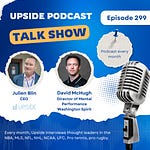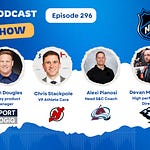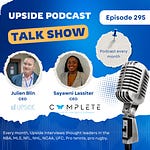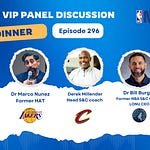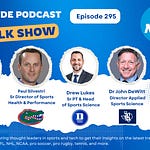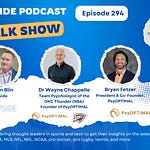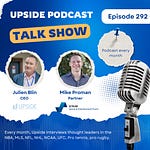This week we had the honor to interview again a group of sports performance experts.
Jordan Troester, PhD, Director of sports performance and sports science at the University of Oregon (UO), a top NCAA organization.
Drew Lukes, Senior PT at Duke University and the head of sports science for Duke university’s women soccer team, a top NCAA team.
Pierre Barrieu, Director of performance for the Canadian men national soccer team.
You can read the full transcript of the podcast interview with Drew, Jordan and Pierre located at the top of this blog post.
Here are some of the best quotes of our conversation with them:
Q1. Are there specific metrics or patterns that have proven predictive for injuries in your respective sports?
Pierre Barrieu
"I don’t think there’s any specific metrics or pattern that are purely predictive of injury, but there are key metrics we monitor to reduce risk. Injury will happen no matter what, but if we manage these metrics properly, we can at least reduce the likelihood."
"In soccer, [among many other KPIs] we monitor high-speed running, sprint distance, and acceleration/deceleration loads. The challenge is ensuring consistency across organizations so that our methods remain relevant. Personally, I’ve moved towards microdosing key workload metrics daily rather than relying on big or small training days. This approach allows for better adaptation and load management.”
Drew Lukes
"From a rehab perspective, I pay close attention to decelerations, especially for athletes returning from ACL injuries. Eccentric loading during deceleration places a significant strain on the knee, and if an athlete isn’t adequately prepared, it increases their reinjury risk."
"We try to set thresholds based on pre-injury data so that when an athlete returns, they aren’t suddenly exposed to a massive spike in workload, which could put them at risk."
Jordan Troester
"It’s not about predictive metrics—it’s about quality processes. Can we profile the strengths and weaknesses of our athletes? Do we have a large enough normative database to know what ‘good’ looks like? And can we create targeted training interventions to individualize our approach?"
"Load accumulation is key. Can we progressively build our athletes’ tolerance to training and match demands in a way that allows them to perform, recover, and repeat consistently?"
Q2. With changing playing environments (e.g., artificial turf vs. natural grass), how are you adapting your injury prevention protocols?
Pierre Barrieu
"I’ve lived this challenge firsthand. At Toronto FC, we started preseason training in an indoor [hard and old] turf field with high temperatures, then [sometimes] moved to a frozen outdoor field, and later played on a pristine stadium pitch [in a -20 degrees weather]. Constantly switching surfaces created issues, and I realized that trying to optimize by constantly changing surfaces wasn’t actually the best strategy."
"In hindsight, I would prioritize consistency—even if that meant training more frequently on an artificial surface. It’s about managing what’s available rather than constantly changing environments, which can lead to more harm than good.”
Jordan Troester
"At Oregon, we deal with 100% artificial turf surfaces due to our wet climate. One of the biggest challenges is bone stress injuries, particularly in the lower limbs. We don’t have a perfect solution yet, but working with facilities staff to maintain and optimize the quality of the turf has been a key part of our injury prevention approach."
Drew Lukes
"We’re fortunate that 99% of our games in the ACC are on natural grass. That consistency is a huge advantage because we don’t have to constantly adapt to surface changes."
Q3. How do you integrate neurocognitive training into rehab protocols, especially for athletes recovering from major injuries like ACL tears or concussions?
Drew Lukes
"Rehab, like everything else, goes through phases where certain things become ‘hot topics.’ Neurocognitive training is one of those right now. But that doesn’t mean it isn’t important—it just means we need to integrate it effectively rather than treating it as a fad."
"For me, it starts on Day 1. If an athlete is recovering from ACL surgery, instead of just having them do quad sets passively, I’ll have them engage in a cognitive task while doing them—like watching a match and squeezing their quad every time a pass is completed. This keeps them mentally engaged and simulates decision-making in a game."
"Later in rehab, we’ll introduce balance work while performing cognitive tasks, like reacting to numbers and colors on a screen. Virtual reality is another tool that’s becoming more common."
Pierre Barrieu
"I’ve used VR in the past, but one thing I’ve learned is that you have to be smart with your budget. Not every technology is worth the investment. The key is picking neurocognitive strategies that are simple, effective, and scalable for most players."
Jordan Troester
"I focus more on mid-to-late-stage rehab and believe in early skill integration. If a football player is coming back from a lower-body injury, I’ll have them do strength work but also mix in catching passes from a machine in between sets. The earlier we can reintroduce sport-specific skills, the better."
"I also use strobe eyewear in training to add a neurocognitive challenge. Even if it’s a simple skill, adding a visual processing component forces athletes to engage more and simulate game-like demands."
Q4. How are NCAA and FIFA teams addressing sleep as a critical component of performance and recovery?
Pierre Barrieu
"There are so many different scenarios to consider—are you in a three-week camp leading up to a major tournament, or are you dealing with players flying across time zones for [ a 10 datys, 2 matches]international duty? The answer varies, but the key is exposing athletes to strategies and letting them find what works best for them."
"For example, when I was at Leeds United, we introduced red light therapy for sleep optimization [while travelling from the UK to Australia for preseason]. About half the team adopted it into their routine, and they still use it today. That’s how you make a lasting impact—through education and giving players tools they can integrate into their habits."
"Jet lag management is another huge factor. I try to have [players adapt to destination time the day of travel to adapt sleep patterns on the plane, if necessary, and adjust faster. It’s all about controlling light exposure [at crucial times in the plane], hydration, and noise levels."
Drew Lukes
"In the NCAA, sleep is a massive issue—not just because of travel, but because these are still college students. They have classes, social lives, and academic pressures, which often make sleep the first thing they sacrifice."
"Without proper education, athletes don’t see sleep as a performance enhancer. Our job is to help them understand that sleep impacts everything—from injury risk to cognitive function and recovery."
Jordan Troester
"We focus a lot on educating both athletes and coaches about the importance of sleep. Some sports have a culture of early morning training sessions, but if we’re waking up athletes at 6 AM for workouts, we might be doing more harm than good. Scheduling is crucial."
"With the new NCAA travel requirements, we’re also working with operations staff to optimize travel schedules and ensure athletes have real opportunities to sleep, which hasn’t always been a priority in the past."
You may also like:
🔥Upside Chat with Andrea Hudy (UCONN/NCAA), Drew Lukes (Duke University/NCAA), Michael Messer (Nashville SC/MLS) on Commonalities & Differences Between the NCAA & MLS.
This week we had the honor to interview again a group of sports performance experts.
🔥Upside Chat with Pierre Barrieu (Canada Soccer), Adam Quigley (MLS/NFL), Alexi Pianosi (Colorado Avalanche/NHL) on Concussions, ChatGPT, the Offseason, Mbappe, and More.
This week we had the honor to interview again a group of sports performance experts.
⭐ Upside Analysis: Why the NCAA is the Next Big Opportunity for Startups
We have been working with teams in the MLS, NBA, NFL, NHL, MLB, NCAA, European soccer leagues, pro tennis, pro rugby as well as Olympic teams for over 10 years. Historically most sports tech startups have focused on the top professional teams (NBA, NFL, MLS, MLB, NHL). However, in the past few years we have seen a large number of sports tech startups in…







